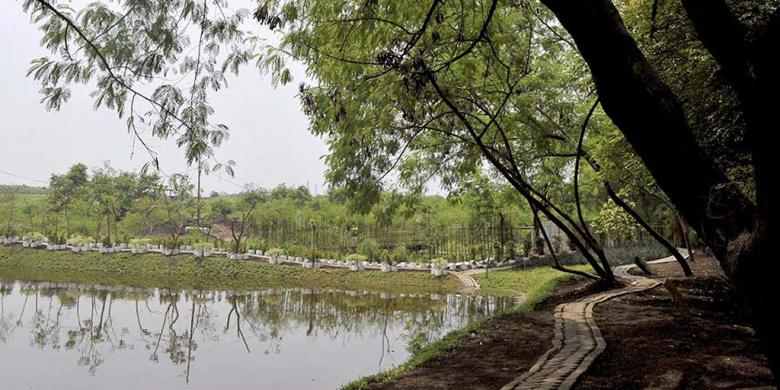Oleh: Pingkan E Dundu

KOMPAS/RADITYA HELABUMI
Selain untuk menampung sampah, sejumlah lahan di tempat pembuangan akhir (TPA) Rawa Kucing, Neglasari, Kota Tangerang, Banten, dimanfaatkan untuk taman dan kolam ikan, Rabu (25/2/2015).
TANGERANG, KOMPAS - Tempat Pembuangan Akhir Rawa Kucing di Kota Tangerang mematahkan mitos bahwa timbunan sampah warga selalu identik dengan bau busuk dan segala hal menjijikkan lainnya.
Di Rawa Kucing justru menghampar taman hijau dengan pepohonan tinggi dan bonsai dilengkapi saung untuk bersantai. Warga pun bisa berwisata gratis, sekaligus belajar mengolah sampah yang ramah lingkungan.
Wajah baru TPA Rawa Kucing seluas 34,8 hektar di Kelurahan Kedaung Wetan, Kecamatan Neglasari, Kota Tangerang, Banten, ini dirintis sejak tahun lalu. "Terobosan dengan teknologi ramah lingkungan, TPA bisa jadi tempat wisata bersih lagi indah," kata Kepala TPA Rawa Kucing Masnan.
Jalan setapak dari bata beton (paving block) selebar 1-1,5 meter membelah taman. Saat ini, baru 1.000 meter persegi dari total luas TPA yang menjadi taman dan fasilitasnya. Tercatat ada 50 jenis tanaman, termasuk pohon keras, pohon pelindung, juga tanaman hias turut tumbuh subur, seperti ketapang, trembesi, sengon, lavender, dan kamboja jepang.
Di sisi timur taman itu, ada kolam ikan berukuran 40 meter x 60 meter. Air kolam berasal dari sumber mata air dari tanah bekas tumpukan sampah yang ada sebelum penataan Rawa Kucing dilakukan. Pekan lalu, 10.000 bibit mujair ditebar ke dalam kolam itu. Permainan air mancur menari di tengah kolam menyejukkan mata yang memandanginya.
Bersebelahan dengan taman, di sisi utara membentang lahan dilapisi hijau rumput seluas 30 meter x 15 meter yang difungsikan sebagai lapangan futsal. Siapa pun tak mengira bahwa
di bawah lahan hijau itu bekas tumpukan sampah yang sudah diratakan.
"Di sini juga akan dikembangkan pertanian terpadu. Masyarakat dan anak sekolah nanti bisa belajar bagaimana memilah sampah dengan teknologi dan pembuatan kompos," kata Kepala Dinas Kebersihan dan Pertamanan Kota Tangerang Ivan Yulianto.
Jika semua rencana terealisasi, TPA Rawa Kucing akan menjadi tempat wisata edupark atau taman pendidikan berwawasan lingkungan sekaligus hutan kota. Agar akses warga makin terbuka ke Rawa Kucing, Ivan mendambakan segera
ada pelebaran jalan menuju TPA.
"Awalnya, saya tidak percaya kalau TPA bisa seperti ini," kata Achmad Irfan (28), warga Sangiang Jaya, Periuk, Kota Tangerang. Ia datang ke tempat itu diajak temannya untuk bermain futsal. Diharapkan daerah lain pun bisa menata kawasan TPA seperti di Rawa Kucing.
Limbah kopi
Dalam sehari, 1.000 ton sampah yang dihasilkan warga dan industri di Kota Tangerang masuk ke TPA Rawa Kucing. Sementara masih ada sekitar 300 meter kubik sampah per hari yang diolah di tingkat warga, sampah bernilai ekonomi yang ditampung bank sampah dan selebihnya ditangani oleh komunitas warga. Namun, tetap ada sebagian sampah warga yang dibuang ke kali dan saluran air.
Dengan volume sampah seperti sekarang, dalam lima tahun ke depan TPA Rawa Kucing sudah kelebihan kapasitas. Untuk itu, Pemerintah Kota Tangerang meningkatkan upaya pengolahan sampah di tingkat lingkungan permukiman warga.
Sekretaris Dinas Kebersihan Kota Tangerang Sugiharto Achmad Bagja mengatakan, pihaknya menggenjot penggunaan teknologi fermentasi dengan menggunakan limbah kopi untuk mempercepat proses pengolahan sampah menjadi pupuk kompos.
Dinas kebersihan mencoba membandingkan tumpukan sampah yang dilapisi limbah kopi dengan yang dilapisi sekam. Pada hari ke-27, sampah setinggi 1,5 meter yang diberi kopi susut hingga tersisa tumpukan setinggi 40 sentimeter. Sementara sampah yang menggunakan lapisan sekam susut hingga 50 sentimeter. Dekomposisi sampah terbukti lebih cepat dengan limbah kopi.
Menurut Sugiharto, limbah kopi bisa mengendalikan vektor penyakit karena sampah tertutup dan bau tereduksi, bahkan bau kopi bisa lebih dominan.
Pasokan limbah kopi, kata Ivan, mereka dapatkan dari bank sentra sampah yang diperoleh secara gratis dari sejumlah industri produk kemasan kopi yang selama ini bercokol di Kota Tangerang dan Kabupaten Tangerang.
Baru langkah awal
Kerja sama dengan pihak swasta ini menjadi secercah harapan mengatasi masalah Kota Tangerang. Di daerah yang dipenuhi industri dan permukiman yang terus tumbuh berjejalan seiring dengan perkembangan kota, sekaligus imbas dari pertumbuhan tetangganya, ibu kota Jakarta, sampah selalu menjadi masalah kronis.
Bahkan, pada 2008, Kota Tangerang mendapat julukan sebagai "Kota Terkotor" versi Kementerian Lingkungan Hidup. Namun, upaya menggandeng warga, komunitas, dan pelaku usaha untuk mengolah sampah yang dilakukan jauh sebelum pembenahan di TPA Rawa Kucing mengantar kota ini menjadi salah satu penerima Adipura sebagai "Kota Tebersih" pada 2009. Pada 2013 dan 2014, Kota Tangerang berhasil menyabet Adipura Kencana.
Keberhasilan dalam mengolah sampah membuat Badan Pengelola Sampah dan Kebersihan Malaysia datang berguru mengolah sampah di Kota Tangerang, akhir Januari lalu. Lembaga Riset Muda Indonesia juga memilih Kota Tangerang sebagai kota pertama di Indonesia untuk dijadikan riset proyek dalam pengujian dan pengolahan sampah berbasis ramah lingkungan.
Meskipun masalah sampah belum total terurai, bagi Wali Kota Tangerang Arief R Wismansyah, langkah awal ini menunjukkan upaya kotanya menjadi layak huni, layak berinvestasi, dan layak dikunjungi sudah dalam koridor yang tepat. Semoga.



